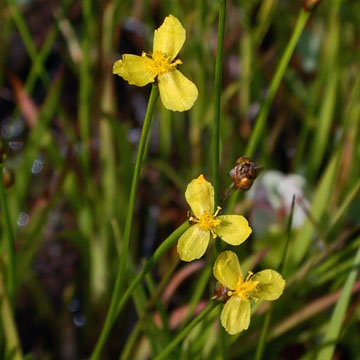

Xyris difformis - (image 1 of 5)
Taxonomy
Family: Xyridaceae
Habitat
Low, wet sandy areas, often in river swamps.
Associates
Distribution
Coastal region from southern ME to FL and TX, less commonly inland to MI, IN, WI, and OK.
Morphology
Herbaceous perennial; leaves broadly linear or elliptic-linear, mostly 10-50 cm long and 5-15 mm wide, spreading, lustrous dark green, anthocyanic at the dilated, soft, thin, keeled base; scapes 15-70 cm, terete and twisted below, straighter above and somewhat compressed, with two broad thin ridges that may be together as wide as the body; spikes 5-15 mm at maturity, ovoid to subglobose, blunt or acute; lateral sepals shortly included, the broad keel lacerate in its upper half; petal blades cuneate, 4 mm, yellow, unfolding in the morning; seeds 0.5-0.6 mm, broadly ellipsoid, finely ribbed.
Notes
Flowers July to September
Wetland indicator: OBL
Vegetatively similar and overlapping the range of X. montana in northeast PA, NY and New England, differing in having wider leaves (5-15 mm vs. 1-2.5 mm wide).
The important feature for identification of Xyris spp. is usually the lateral sepals (specifically the keel) which are obscured by the bracts of the inflorescence in most species, making identification from photographs very difficult. In two species, X. caroliniana and X. fimbriata, the tips of the lateral sepals are fimbriate and surpass the subtending bracts making identification of these easier without dissecting the inflorescence, especially for plants in fruit.
References
Gleason, Henry A. and A. Cronquist. 1991. Manual of Vascular Plants of Northeastern United States and Adjacent Canada. Second Ed.
The New York Botanical Garden. Bronx, NY
USDA, NRCS. 2002. The PLANTS Database, Version 3.5 (http://plants.usda.gov).
National Plant Data Center, Baton Rouge, LA 70874-4490 USA.
|
Michael Hough © 2018 |